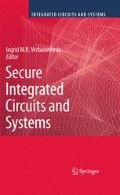Abstract
The supply current variations, which are being analyzed to find the secret information, are the aggregated effect of the supply current variations of the individual switching logic gates that make up the microcontroller- or ASIC-based encryption system under attack. The fundamental reason that the information is leaked through the power supply is that the logic gates have an asymmetric power consumption. Indeed, as discussed in Section 2.1, only when the output of the logic gate makes a 0–1 transition, a current comes from the power supply and charges the output capacitance. In all other cases, no or only a limited amount of energy (due to short circuit or leakage) is consumed from the power supply. Hence by observing the supply current, one has information on the switching event and the state of the logic gate.
Access this chapter
Tax calculation will be finalised at checkout
Purchases are for personal use only
References
D. Suzuki, M. Saeki, T. Ichikawa, “Random Switching Logic: A Countermeasure against DPA based on Transition Probability,” Cryptology ePrint Archive, report 2004/346, 2004.
T. Popp, S. Mangard, “Masked Dual-Rail Pre-charge Logic: DPA Resistance without the Routing Constraints,” Proceedings of the Workshop on Cryptographic Hardware and Embedded Systems, LNCS 3659, p. 172–186, August 2005.
Z. Chen, Y. Zhou, “Dual-Rail Random Switching Logic: A Countermeasure to Reduce Side Channel Leakage,” Proceedings of the Workshop on Cryptographic Hardware and Embedded Systems, LNCS 4249, p. 242–254, October 2006.
P. Schaumont, and K. Tiri, “Masking and Dual-Rail Logic don’t Add up”, Workshop on Cryptographic Hardware and Embedded Systems, September 2007.
E. Oswald, S. Mangard, C. Herbst, S. Tillich “Practical Second-Order DPA Attacks for Masked Smart Card Implementations of Block Ciphers” CT-RSA, pp. 192–207, 2006.
T. Popp, M. Kirschbaum, T. Zefferer, S. Mangard “Evaluation of the Masked Logic Style MDPL on a Prototype Chip” Workshop on Cryptographic Hardware and Embedded Systems, September 2007.
K. Tiri, I. Verbauwhede, “A Dynamic and Differential CMOS Logic Style to Resist Power and Timing Attacks on Security IC’s”, IACR eprint archive, report 2004/066, 2004.
Z. T. Deniz, Y. Leblebici, “Low-Power Current Mode Logic for Improved DPA-Resistance in Embedded Systems”, International Symposium on Circuits and Systems, pp. 1059–1062, May 2005:
I. Hassoune, F. Mace, D. Flandre, J.-D. Legat, “Low-Swing Current Mode Logic (LSCML): A New Logic Style for Secure and Robust Smart Cards against Power Analysis Attacks”, Microelectronics Journal, vol. 37, pp. 997–1006, May 2006.
S. Moore, R. Anderson, R. Mullins, G. Taylor “Balanced Selfchecking Asynchronous Logic for Smart Card Applications,” Journal of Microprocessors Microsystems, vol. 27.9, pp. 421–430, 2003.
K. Kulikowski, A. Smirnov, A. Taubin “Automated Design of Cryptographic Devices Resistant to Multiple Side-Channel Attacks” Workshop on Cryptographic Hardware and Embedded Systems, LNCS, pp. 399–413, 2006.
G. Bouesse, M. Renaudin, S. Dumont, F. Germain, “DPA on Quasi Delay Insensitive Asynchronous Circuits: Formalization and Improvement” DATE 2005, pp. 424–429.
K. J. Kulikowski, M. Su, A. B. Smirnov, A. Taubin, M. G. Karpovsky, D. MacDonald, “Delay Insensitive Encoding and Power Analysis: A Balancing Act” ASYNC 2005, pp. 116–125.
K. J. Kulikowski, M. G. Karpovsky, A. Taubin “Power Attacks on Secure Hardware Based on Early Propagation of Data” International On-Line Testing Symposium, pp. 131–138, 2006.
K. Tiri, M. Akmal, and I. Verbauwhede, “A Dynamic and Differential CMOS Logic with Signal Independent Power Consumption to Withstand Differential Power Analysis on Smart Cards”, European Solid-State Circuits Conference, pp. 403–406, September 2002.
F. Mace, F.-X. Standaert, I. Hassoune, J.-J. Quisquater, J.-D. Legat, “A Dynamic Current Mode Logic to Counteract Power Analysis Attacks”, Conference on Design of Circuits and Integrated Systems, pp. 186–191, November 2004
K. Tiri, and I. Verbauwhede, “A Logic Level Design Methodology for a Secure DPA Resistant ASIC or FPGA Implementation”, Design, Automation and Test in Europe Conference, pp. 246–251, February 2004.
K. Tiri, and I. Verbauwhede, “Place and Route for Secure Standard Cell Design”, International Conference on Smart Card Research and Advanced Applications, pp. 143–158, August 2004.
K. Tiri, and I. Verbauwhede, “A Digital Design Flow for Secure Integrated Circuits”, IEEE Transactions on Computer-Aided Design of Integrated Circuits and Systems, vol. 25, no. 7, pp. 1197–1208, July 2006.
K. Tiri, D. Hwang, A. Hodjat, B.-C. Lai, S. Yang, P. Schaumont, and I. Verbauwhede, “Prototype IC with WDDL and Differential Routing – DPA Resistance Assessment”, Workshop on Cryptographic Hardware and Embedded Systems, LNCS, vol. 3659, pp. 354–365, August 2005.
H. Li, A. Markettos, S. Moore “Security Evaluation Against Electromagnetic Analysis at Design Time” Workshop on Cryptographic Hardware and Embedded Systems, pp. 280–292, 2005.
K. Tiri, and I. Verbauwhede, “Simulation Models for Side-Channel Information Leaks”, Design Automation Conference, pp. 228–233, June 2005.
P. Kocher, R. Lee, G. McGraw, A. Raghunathan, S. Ravi “Security as a New Dimension in Embedded System Design” Design Automation Conference, pp.735–760, 2004.
D. Hwang, P. Schaumont, K. Tiri, and I. Verbauwhede, “Securing Embedded Systems”, IEEE Security & Privacy Magazine, vol.4, no. 2, pp. 40–49, April 2006.
Author information
Authors and Affiliations
Corresponding author
Editor information
Editors and Affiliations
Rights and permissions
Copyright information
© 2010 Springer Science+Business Media, LLC
About this chapter
Cite this chapter
Tiri, K. (2010). Side-Channel Resistant Circuit Styles and Associated IC Design Flow. In: Verbauwhede, I. (eds) Secure Integrated Circuits and Systems. Integrated Circuits and Systems. Springer, Boston, MA. https://doi.org/10.1007/978-0-387-71829-3_8
Download citation
DOI: https://doi.org/10.1007/978-0-387-71829-3_8
Published:
Publisher Name: Springer, Boston, MA
Print ISBN: 978-0-387-71827-9
Online ISBN: 978-0-387-71829-3
eBook Packages: EngineeringEngineering (R0)

